Marine Natural Gas Hydrate Self-Entry Exploitation Device: Evaluation of Production Enhancement Measures
Abstract
1. Introduction
2. The Self-Entry Exploitation Device
2.1. Basic Production Process
- Gas–liquid lifting system comprises conveying pipelines (gas and liquid), a lifting power device, and a gas–liquid separator. With one end attached to the cavity and the other output through the pipelines, it can elevate the liquid and gas within the cavity to lower its internal pressure, which lowers the pressure of surrounding reservoirs, thereby driving the NGH decomposition. Then, natural gas and water enter the cavity through the sand control device due to the pressure difference and lift them to offshore platforms.
- The sand control device locates between two perforated pipe walls, which can be devised as a sand-control screen, a sand-control sieve tube, a mechanical sieve tube, a gravel sand-control layer, or a flexible fabric sand-control material layer. It can cover the inner wall of the open hole wall and filter the liquid and gas into the cavity while filtering mud and sand.
- Central weight can greatly enhance the overall structural strength and weight of the SEED, which is chosen to use according to the actual situation.
2.2. Feasibility Analysis
- Torpedo anchors have been widely used in ocean engineering, for instance, the Marlim oilfield and the Albacora oilfield in Brazil (penetration depth is 1.5~2.4 times of anchor length) and the Gjøa oilfield in Norway (penetration depth is 1.9~2.4 times of anchor length) [72,73]. Therefore, the maximum length of the new device only needs to reach about 100 m to cover most hydrate reservoirs.
- Conventional wellbores are mostly made of plain concrete, while the SEED is composed of steel materials, allowing it to have higher strength and stiffness to withstand greater pressure reduction and promote the in situ decomposition rate of NGH.
- The casing diameter of the conventional wellbore in the reservoir section is usually around Ø220.5 mm. In order to further expand this range, complex wellbore expansion technology is required [42]. For SEED, the larger the diameter, the heavier the weight, which means it can penetrate into the reservoir easier. In addition, whether it is wellbores or the SEED, having a larger diameter in the production section means a larger contact area with the reservoirs, which can expand the NGH dissociation area.
2.3. Previous Preliminary Findings
- Simulation by coupled Eulerian–Lagrangian method [76], the penetration process of the SEED lasts about 4 s in Shenhu reservoir, which takes a short time from impacting the seabed to reaching the NGH reservoir. In addition, the SEED is designed to penetrate the depth range of 20~370 m.
- The SEED consists of a prefabricated steel structure with higher strength and rigidity to achieve greater pressure drop (production pressure can reach 1 MPa), which greatly increases the decomposition rate of surrounding NGH.
- The SEED diameter in the reservoir section is larger than the conventional wellbore diameter, further expanding the NGH decomposition area. Moreover, the diameter d = 1.5 m is the most cost-effective value. As the diameter enlarges further, the benefits start to decrease. The device can also be used as a heat injection platform (heat transfer device) in conjunction with the SEED or existing wellbores for combined depressurization and thermal stimulation to achieve rapid reheat of the low-temperature zone of the reservoir.
2.4. Production Enhancement Measures
3. Exploitation Model Description
3.1. Numerical Model
- Three phases (gas phase, liquid phase, and solid phase) and three components (dissociation gas component, liquid component, and NGH component) were considered, where NGH was treated as a solid phase existing in porous media in the form of spherical particles [49].
- The reservoir was considered homogeneous, including porosity, permeability, etc. In the NGH reservoir, heat conduction, heat convection, ice generation, and endothermic NGH dissociation were considered.
- The dissociated NGH flow is a single-phase compressible gas flow that satisfies Darcy’s law. The sediment pore capillary force was calculated using the Van Genuchten formula [82]. The relationship between effective permeability and porosity was established according to the Carmen Kozeny model (formulas are shown in Table 1) [83].
3.2. Hydrates in the Shenhu Area
| Parameter | Value | Unit |
|---|---|---|
| Thickness | OL and UL: 15; NBL: 36; ML: 15; FGL: 27 | m |
| Porosity | OL and UL: 0.3; NBL: 0.35; ML: 0.33; FGL: 0.32 | / |
| Initial permeability | OL and UL: kox = koy = 2, koz = 1; NBL: kox = koy = 2.9, koz = 1.45 ML: kox = koy = 1.5, koz = 0.75; FGL: kox = koy = 7.4, koz = 3.7 | ×10−3 μm2 |
| Initial saturation | OL and UL: Sh = 0, Sw = 1, Sg = 0; NBL: Sh = 0.34, Sw = 0.66, Sg = 0 ML: Sh = 0.31, Sw = 0.526, Sg = 0.164; FGL: Sh = 0, Sw = 0.922, Sg = 0.078 | / |
| NGH molar mass | 0.119543 | kg/gmole |
| NGH density | 919.7 | kg/m3 |
| Seawater density | 1020 | kg/m3 |
| Thermal conductivity | Rock: 2.7; Water: 0.69; NGH: 0.5 | W/m/K |
| Formation temperature | T = 14.475 + 0.03z, z is the depth (m) | °C |
| Formation pressure | P = 1.469 + 0.01z, z is the depth (m) | MPa |
| Phase balance relation | ||
| Permeability variation model [83] | ||
| Porosity variation model | ||
| Capillary force model [82] | ||
4. Cases Design and Results
4.1. Control Group
4.2. Single Exploitation Mode
4.2.1. Open-Hole Position Adjustment
4.2.2. Inner Wall Heating
4.3. Clustered Exploitation Mode
4.3.1. Clustered Depressurization
4.3.2. Depressurization Combined Thermal Stimulation
5. Conclusions and Suggestions
- (1)
- Unlike conventional wellbores, the SEED consists of a prefabricated steel structure with higher strength and stiffness, allowing for greater depressurization and improved in situ recovery efficiency. Furthermore, the diameter into the reservoir is much larger than the wellbore diameter for casing construction, thereby expanding the NGH decomposition area.
- (2)
- The gas production in NBL, ML, and FGL with simultaneous openings performs well than single-layer openings, which can expand the contact areas between the device and NGH reservoirs. Thus, it is recommended that all reservoir layers be open-hole exploited by the SEED simultaneously when carrying out the open-hole position adjustment.
- (3)
- The effect of inner wall heating is limited but sufficient to achieve the goal of clogging prevention. In actual production, this measure is beneficial to improve gas production, especially with low production pressure and a short production cycle, which is better than the pure depressurization exploitation scenario. For long-term production, the impact of this measure is restricted under normal production pressure (P = 4 MPa).
- (4)
- Clustered depressurization must be able to significantly increase the capacity of NGH, which is an important measure to cross the threshold of commercial exploitation. In addition, various arrangement parameters make a difference in the production enhancement effect, especially the spacing. Indeed, we need to select a reasonable spacing according to a combination of expected production cycle time and pressure.
- (5)
- The SEED has the potential to adopt depressurization combined with thermal stimulation exploitation. However, it seems to have performed terribly in the Shenhu reservoir, where the reservoir character is poor (low permeability, low thermal conductivity, etc.). Therefore, it is not recommended in clayey soil reservoirs with poor permeability conditions.
- (6)
- Figure 13 shows the increasing rate of gas production compared with the control group, which allows us to determine which measure to adopt according to different periods (100 d, 200 d, 300 d, …, 1000 d).
Author Contributions
Funding
Institutional Review Board Statement
Informed Consent Statement
Data Availability Statement
Conflicts of Interest
References
- Sloan, E.D. Fundamental principles and applications of natural gas hydrates. Nature 2003, 426, 353–359. [Google Scholar] [CrossRef]
- Kvenvolden, K.A. Methane hydrate—A major reservoir of carbon in the shallow geosphere? Chem. Geol. 1988, 71, 41–51. [Google Scholar] [CrossRef]
- Zeng, H.; Zhang, Y.; Zhang, L.; Chen, Z.; Li, X. Effects of the NaCl Concentration and Montmorillonite Content on Formation Kinetics of Methane Hydrate. J. Mar. Sci. Eng. 2022, 10, 548. [Google Scholar] [CrossRef]
- Makogon, Y.F. Natural gas hydrates—A promising source of energy. J. Nat. Gas Sci. Eng. 2010, 2, 49–59. [Google Scholar] [CrossRef]
- Lu, S.M. A global survey of gas hydrate development and reserves: Specifically in the marine field. Renew. Sustain. Energy Rev. 2015, 41, 884–900. [Google Scholar] [CrossRef]
- Lee, S.Y.; Holder, G.D. Methane hydrates potential as a future energy source. Fuel Process. Technol. 2001, 71, 181–186. [Google Scholar] [CrossRef]
- Ye, H.; Wu, X.; Li, D.; Jiang, Y. Numerical simulation of productivity improvement of natural gas hydrate with various well types: Influence of branch parameters. J. Nat. Gas Sci. Eng. 2022, 103, 104630. [Google Scholar] [CrossRef]
- Nasir, Q.; Suleman, H.; Elsheikh, Y.A. A review on the role and impact of various additives as promoters/ inhibitors for gas hydrate formation. J. Nat. Gas Sci. Eng. 2020, 76, 103211. [Google Scholar] [CrossRef]
- Roostaie, M.; Leonenko, Y. Gas production from methane hydrates upon thermal stimulation; an analytical study employing radial coordinates. Energy 2020, 194, 116815. [Google Scholar] [CrossRef]
- Shi, K.; Wei, R.; Guo, X.; Li, Q.; Lv, X.; Fan, Q.; Dong, H.; Yang, L.; Zhao, J.; Song, Y. Enhancing Gas Production from Hydrate-Bearing Reservoirs through Depressurization-Based Approaches: Knowledge from Laboratory Experiments. Energy Fuels 2021, 35, 6344–6358. [Google Scholar] [CrossRef]
- Wei, W.N.; Li, B.; Gan, Q.; Li, Y.L. Research progress of natural gas hydrate exploitation with CO2 replacement: A review. Fuel 2022, 312, 122873. [Google Scholar] [CrossRef]
- Zhou, S.; Li, Q.; Lv, X.; Fu, Q.; Zhu, J. Key issues in development of offshore natural gas hydrate. Front. Energy 2020, 14, 433–442. [Google Scholar] [CrossRef]
- Makogon, Y.F.; Omelchenko, R.Y. Commercial gas production from Messoyakha deposit in hydrate conditions. J. Nat. Gas Sci. Eng. 2013, 11, 1–6. [Google Scholar] [CrossRef]
- Moridis, G.J.; Collett, T.S.; Dallimore, S.R.; Satoh, T.; Hancock, S.; Weatherill, B. Numerical studies of gas production from several CH4 hydrate zones at the Mallik site, Mackenzie Delta, Canada. J. Pet. Sci. Eng. 2004, 43, 219–238. [Google Scholar] [CrossRef]
- Collett, T.S. Gas hydrate production testing—Knowledge gained. In Proceedings of the Offshore Technology Conference, Houston, TX, USA, 6–9 May 2019; pp. 6–9. [Google Scholar] [CrossRef]
- Ajayi, T.; Anderson, B.J.; Seol, Y.; Boswell, R.; Myshakin, E.M. Key aspects of numerical analysis of gas hydrate reservoir performance: Alaska North Slope Prudhoe Bay Unit “L-Pad” hydrate accumulation. J. Nat. Gas Sci. Eng. 2018, 51, 37–43. [Google Scholar] [CrossRef]
- Collett, T.S.; Boswell, R.; Lee, M.W.; Anderson, B.J.; Rose, K.; Lewis, K.A. Evaluation of long-term gas hydrate production testing locations on the Alaska north slope. In Proceedings of the OTC Arctic Technology Conference, Houston, TX, USA, 7–9 February 2011; pp. 955–983. [Google Scholar] [CrossRef]
- Yamamoto, K.; Terao, Y.; Fujii, T.; Ikawa, T.; Seki, M.; Matsuzawa, M.; Kanno, T. Operational overview of the first offshore production test of methane hydrates in the Eastern Nankai Trough. In Proceedings of the Offshore Technology Conference, Houston, TX, USA, 5–8 May 2014; pp. 1802–1812. [Google Scholar] [CrossRef]
- Yamamoto, K.; Wang, X.X.; Tamaki, M.; Suzuki, K. The second offshore production of methane hydrate in the Nankai Trough and gas production behavior from a heterogeneous methane hydrate reservoir. RSC Adv. 2019, 9, 25987–26013. [Google Scholar] [CrossRef]
- Wang, P.; Zhu, Y.; Lu, Z.; Bai, M.; Huang, X.; Pang, S.; Zhang, S.; Liu, H.; Xiao, R. Research progress of gas hydrates in the Qilian mountain permafrost, Qinghai, northwest China: Review. Sci. Sin. Phys. Mech. Astron. 2019, 49, 034606. [Google Scholar] [CrossRef]
- Li, J.F.; Ye, J.L.; Qin, X.W.; Qiu, H.J.; Wu, N.Y.; Lu, H.L.; Xie, W.W.; Lu, J.A.; Peng, F.; Xu, Z.Q.; et al. The first offshore natural gas hydrate production test in South China Sea. China Geol. 2018, 1, 5–16. [Google Scholar] [CrossRef]
- Ye, J.L.; Qin, X.W.; Xie, W.W.; Lu, H.L.; Ma, B.J.; Qiu, H.J.; Liang, J.Q.; Lu, J.A.; Kuang, Z.G.; Lu, C.; et al. The second natural gas hydrate production test in the South China Sea. China Geol. 2020, 3, 197–209. [Google Scholar] [CrossRef]
- Mao, L.; Cai, M.; Liu, Q.; Zhang, Y. Parameter optimization for solid fluidization exploitation of natural gas hydrate in South China Sea. Eng. Comput. 2022, 39, 1051–1079. [Google Scholar] [CrossRef]
- Wu, N.; Li, Y.; Wan, Y.; Sun, J.; Huang, L.; Mao, P. Prospect of marine natural gas hydrate stimulation theory and technology system. Nat. Gas Ind. 2020, 40, 100–115. [Google Scholar] [CrossRef]
- Aghajari, H.; Moghaddam, M.H.; Zallaghi, M. Study of effective parameters for enhancement of methane gas production from natural gas hydrate reservoirs. Green Energy Environ. 2019, 4, 453–469. [Google Scholar] [CrossRef]
- Ye, H.; Wu, X.; Guo, G.; Li, D.; Jiang, Y. A Novel Wellbore-Wall Heating Method without External Energy Injection for Natural Gas Hydrate Production—A Heat Transfer Device. J. Mar. Sci. Eng. 2022, 10, 799. [Google Scholar] [CrossRef]
- Li, S.; Li, S.; Zheng, R.; Li, Q.; Pang, W. Strategies for gas production from Class 2 hydrate accumulations by depressurization. Fuel 2021, 286, 119380. [Google Scholar] [CrossRef]
- Li, Q.; Zhou, S.; Zhao, J.; Song, Y.; Zhu, J. Research Status and Prospects of Natural Gas Hydrate Exploitation Technology. Chin. J. Eng. Sci. 2022, 24, 214. [Google Scholar] [CrossRef]
- Uchida, S.; Klar, A.; Yamamoto, K. Sand production model in gas hydrate-bearing sediments. Int. J. Rock Mech. Min. Sci. 2016, 86, 303–316. [Google Scholar] [CrossRef]
- Yoon, H.C.; Yoon, S.; Lee, J.Y.; Kim, J. Multiple porosity model of a heterogeneous layered gas hydrate deposit in Ulleung Basin, East Sea, Korea: A study on depressurization strategies, reservoir geomechanical response, and wellbore stability. J. Nat. Gas Sci. Eng. 2021, 96, 104321. [Google Scholar] [CrossRef]
- Konno, Y.; Masuda, Y.; Akamine, K.; Naiki, M.; Nagao, J. Sustainable gas production from methane hydrate reservoirs by the cyclic depressurization method. Energy Convers. Manag. 2016, 108, 439–445. [Google Scholar] [CrossRef]
- Liang, Y.P.; Liu, S.; Wan, Q.C.; Li, B.; Liu, H.; Han, X. Comparison and optimization of methane hydrate production process using different methods in a single verticalwell. Energies 2019, 12, 124. [Google Scholar] [CrossRef]
- Li, D.L.; Liang, D.Q.; Fan, S.S.; Li, X.S.; Tang, L.G.; Huang, N.S. In situ hydrate dissociation using microwave heating: Preliminary study. Energy Convers. Manag. 2008, 49, 2207–2213. [Google Scholar] [CrossRef]
- Islam, M.R. A new recovery technique for gas production from Alaskan gas hydrates. J. Pet. Sci. Eng. 1994, 11, 267–281. [Google Scholar] [CrossRef]
- Ning, F.; Wu, N.; Jiang, G.; Zhang, L.; Guan, J.; Yu, Y.; Tang, F. A method to use solar energy for the production of gas from marine hydrate-bearing sediments: A case study on the Shenhu Area. Energies 2010, 3, 1861–1879. [Google Scholar] [CrossRef]
- Liu, Y.; Hou, J.; Zhao, H.; Liu, X.; Xia, Z. A method to recover natural gas hydrates with geothermal energy conveyed by CO2. Energy 2018, 144, 265–278. [Google Scholar] [CrossRef]
- Liu, S.; Zhang, Y.; Luo, Y.; Liang, Y.; Li, B. Analysis of hydrate exploitation by a new in-situ heat generation method with chemical reagents based on heat utilization. J. Clean. Prod. 2020, 249, 119399. [Google Scholar] [CrossRef]
- Tupsakhare, S.S.; Castaldi, M.J. Efficiency enhancements in methane recovery from natural gas hydrates using injection of CO2/N2 gas mixture simulating in-situ combustion. Appl. Energy 2019, 236, 825–836. [Google Scholar] [CrossRef]
- Li, S.; Xiao, L.; Sijing, W. A novel method for natural gas hydrate production:de-pressurization and backfilling with in-situ supplemental heat. J. Eng. Geol. 2020, 28, 282–293. [Google Scholar] [CrossRef]
- Yin, Z.; Huang, L.; Linga, P. Effect of wellbore design on the production behaviour of methane hydrate-bearing sediments induced by depressurization. Appl. Energy 2019, 254, 113635. [Google Scholar] [CrossRef]
- Ye, H.; Wu, X.; Li, D.; Jiang, Y. Numerical analysis of gas recovery enhancement from natural gas hydrate reservoir by using a large-diameter casing. Ocean Eng. 2022, 262, 112321. [Google Scholar] [CrossRef]
- Zhang, J.; Li, X.; Chen, Z.; Li, Q.; Li, G.; Lv, T. Numerical simulation of the improved gas production from low permeability hydrate reservoirs by using an enlarged highly permeable well wall. J. Pet. Sci. Eng. 2019, 183, 106404. [Google Scholar] [CrossRef]
- Zhuo, L.; Yu, J.; Zhang, H.; Zhou, C. Influence of horizontal well section length on the depressurization development effect of natural gas hydrate reservoirs. Nat. Gas Ind. 2021, 41, 153–160. [Google Scholar] [CrossRef]
- Yuan, Y.; Xu, T.; Jin, C.; Zhu, H.; Gong, Y.; Wang, F. Multiphase flow and mechanical behaviors induced by gas production from clayey-silt hydrate reservoirs using horizontal well. J. Clean. Prod. 2021, 328, 129578. [Google Scholar] [CrossRef]
- Chong, Z.R.; Zhao, J.; Chan, J.H.R.; Yin, Z.; Linga, P. Effect of horizontal wellbore on the production behavior from marine hydrate bearing sediment. Appl. Energy 2018, 214, 117–130. [Google Scholar] [CrossRef]
- Cranganu, C. In-situ thermal stimulation of gas hydrates. J. Pet. Sci. Eng. 2009, 65, 76–80. [Google Scholar] [CrossRef]
- Feng, Y.; Chen, L.; Suzuki, A.; Kogawa, T.; Okajima, J.; Komiya, A.; Maruyama, S. Numerical analysis of gas production from reservoir-scale methane hydrate by depressurization with a horizontal well: The effect of permeability anisotropy. Mar. Pet. Geol. 2019, 102, 817–828. [Google Scholar] [CrossRef]
- Yu, T.; Guan, G.; Abudula, A.; Yoshida, A.; Wang, D.; Song, Y. Application of horizontal wells to the oceanic methane hydrate production in the Nankai Trough, Japan. J. Nat. Gas Sci. Eng. 2019, 62, 113–131. [Google Scholar] [CrossRef]
- Ye, H.; Wu, X.; Li, D. Numerical simulation of natural gas hydrate exploitation in complex structure wells: Productivity improvement analysis. Mathematics 2021, 9, 2184. [Google Scholar] [CrossRef]
- Mao, P.; Wan, Y.; Sun, J.; Li, Y.; Hu, G.; Ning, F.; Wu, N. Numerical study of gas production from fine-grained hydrate reservoirs using a multilateral horizontal well system. Appl. Energy 2021, 301, 117450. [Google Scholar] [CrossRef]
- Li, Y.L.; Wan, Y.Z.; Chen, Q.; Sun, J.X.; Wu, N.Y.; Hu, G.W.; Ning, F.L.; Mao, P.X. Large borehole with multi-lateral branches: A novel solution for exploitation of clayey silt hydrate. China Geol. 2019, 2, 333–341. [Google Scholar] [CrossRef]
- Ye, H.; Wu, X.; Guo, G.; Huang, Q.; Chen, J.; Li, D. Application of the enlarged wellbore diameter to gas production enhancement from natural gas hydrates by complex structure well in the shenhu sea area. Energy 2022, 264, 126025. [Google Scholar] [CrossRef]
- Zhang, P.; Zhang, Y.; Zhang, W.; Tian, S. Numerical simulation of gas production from natural gas hydrate deposits with multi-branch wells: Influence of reservoir properties. Energy 2022, 238, 121738. [Google Scholar] [CrossRef]
- Zhang, P.; Tian, S.; Zhang, Y.; Li, G.; Zhang, W.; Khan, W.A.; Ma, L. Numerical simulation of gas recovery from natural gas hydrate using multi-branch wells: A three-dimensional model. Energy 2021, 220, 119549. [Google Scholar] [CrossRef]
- Wei, N.; Pei, J.; Zhao, J.; Zhang, L.; Zhou, S.; Luo, P.; Li, H.; Wu, J. A state-of-the-art review and prospect of gas hydrate reservoir drilling techniques. Front. Earth Sci. 2022, 10, 124. [Google Scholar] [CrossRef]
- Gao, D.; Wang, Y. Some Research Progress in Deepwater Drilling Mechanics and Control Technology; CRC Press: Boca Raton, FL, USA, 2019; Volume 40, ISBN 9780429129148. [Google Scholar]
- Wei, C.; Yan, R.; Tian, H.; Zhou, J.; Li, W.; Ma, T.; Chen, P. Geotechnical problems in exploitation of natural gas hydrate: Status and challenges. Nat. Gas Ind. 2020, 40, 116–132. [Google Scholar] [CrossRef]
- Konno, Y.; Jin, Y.; Yoneda, J.; Uchiumi, T.; Shinjou, K.; Nagao, J. Hydraulic fracturing in methane-hydrate-bearing sand. RSC Adv. 2016, 6, 73148–73155. [Google Scholar] [CrossRef]
- Konno, Y.; Fujii, T.; Sato, A.; Akamine, K.; Naiki, M.; Masuda, Y.; Yamamoto, K.; Nagao, J. Key Findings of the World’s First Offshore Methane Hydrate Production Test off the Coast of Japan: Toward Future Commercial Production. Energy Fuels 2017, 31, 2607–2616. [Google Scholar] [CrossRef]
- Zhu, Y.; Wang, P.; Pang, S.; Zhang, S.; Xiao, R. A Review of the Resource and Test Production of Natural Gas Hydrates in China. Energy Fuels 2021, 35, 9137–9150. [Google Scholar] [CrossRef]
- Cen, J.; Li, F.; Li, T.; Huang, W.; Chen, J.; Jiang, F. Experimental study of the heat-transfer performance of an extra-long gravity-assisted heat pipe aiming at geothermal heat exploitation. Sustainability 2021, 13, 12481. [Google Scholar] [CrossRef]
- Xuezhen, W.U.; Hongyu, Y.E.; Yujing, J.; Dayong, L.I.; Jie, J.; Gang, W.; Bin, G. Marine natural gas hydrate self-entry exploitation device and its feasibility. J. Cent. South Univ. Technol. 2022, 53, 1012–1022. [Google Scholar] [CrossRef]
- Xuezhen, W.U.; Hongyu, Y.E.; Dayong, L.I.; Yujing, J.; Qu, W. A novel suction cylinder-type exploitation device and approach for marine natural gas hydrate. Ocean Eng. 2022, 40, 1–10. [Google Scholar] [CrossRef]
- Li, W.; Chen, X.; Hu, Y.; Xia, Y.; Yang, M.; Chen, H. Research on mining mechanism of gas hydrate capping and pressure reducing device. Chin. J. Appl. Mech. 2020, 5, 2146–2152. [Google Scholar] [CrossRef]
- Xu, H.L.; Kong, W.Y.; Hu, W.G. Analysis of influencing factors on suction capacity in seabed natural gas hydrate by cutter-suction exploitation. J. Cent. South Univ. 2018, 25, 2883–2895. [Google Scholar] [CrossRef]
- Zhao, J.; Zhou, S.; Zhang, L.; Wu, K.; Guo, P.; Li, Q.; Fu, Q.; Gao, H.; Wei, N. The first global physical simulation experimental systems for the exploitation of marine natural gas hydrates through solid fluidization. Nat. Gas Ind. 2017, 37, 15–22. [Google Scholar] [CrossRef]
- Wang, G.; Zhong, L.; Zhou, S.; Liu, Q.; Li, Q.; Fu, Q.; Wang, L.; Huang, R.; Wang, G.; Li, X. Jet breaking tools for natural gas hydrate exploitation and their support technologies. Nat. Gas Ind. 2017, 37, 68–74. [Google Scholar] [CrossRef]
- Song, Z.; Sun, Y.; Li, K.; Lü, Z.; Sun, H. Research of umbrella-like tool for solid fluidization exploitation of shallow non-diagenetic gas hydrates in deep water. Nat. Gas Ind. 2019, 39, 133–139. [Google Scholar] [CrossRef]
- Song, Z.; Li, K.; Sun, J.; Lü, Z. New broaching exploitation method and feasibility analysis of marine gas hydrate reservoirs. Guocheng Gongcheng Xuebao/Chin. J. Process Eng. 2020, 20, 1234–1240. [Google Scholar] [CrossRef]
- Wu, X.; Ye, H.; Jiang, Y.; Li, D.; Wang, G. Development of a novel self-entry exploitation device for marine natural gas hydrate and the feasibility studies. Ocean Eng. 2022, 254, 111365. [Google Scholar] [CrossRef]
- Ye, H.; Wu, X.; Li, D.; Jiang, Y.; Gong, B. A novel thermal stimulation approach for natural gas hydrate exploitation—the application of the self-entry energy compensation device in the Shenhu sea. J. Nat. Gas Sci. Eng. 2022, 105, 104723. [Google Scholar] [CrossRef]
- Brandão, F.E.N.; Henriques, C.C.D.; Araújo, J.B.; Ferreira, O.C.G.; dos Santos Amaral, C. Albacora Leste Field Development- FPSO P-50 Mooring System Concept and Installation. In Proceedings of the Offshore Technology Conference, Houston, TX, USA, 1–4 May 2006. [Google Scholar]
- Lieng, J.T.; Tjelta, T.I.; Skaugset, K. Installation of two prototype deep penetrating anchors at the Gjøa Field in the North Sea. In Proceedings of the Offshore Technology Conference, Houston, TX, USA, 3–6 May 2010; pp. 1999–2007. [Google Scholar] [CrossRef]
- Obzhirov, A.I.; Emelyanova, T.A.; Telegin, Y.A.; Shakirov, R.B. Gas Flows in the Sea of Okhotsk Resulting from Cretaceous-Cenozoic Tectonomagmatic Activity. Russ. J. Pac. Geol. 2020, 14, 156–168. [Google Scholar] [CrossRef]
- DD 2012-08; Marine Gas Hydrate Geological Exploration Specification. Ministry of Natural Resources of the People’s Republic of China: Beijing, China, 2012. Available online: https://geocloud.cgs.gov.cn/std/?standard (accessed on 14 February 2023).
- Qiu, G.; Henke, S.; Grabe, J. Application of a Coupled Eulerian-Lagrangian approach on geomechanical problems involving large deformations. Comput. Geotech. 2011, 38, 30–39. [Google Scholar] [CrossRef]
- Swinkels, W.J.A.M.; Drenth, R.J.J. Thermal reservoir simulation model of production from naturally occuring gas hydrate accumulations. SPE Reserv. Eval. Eng. 2000, 3, 559–566. [Google Scholar] [CrossRef]
- Myshakin, E.M.; Gaddipati, M.; Rose, K.; Anderson, B.J. Numerical simulations of depressurization-induced gas production from gas hydrate reservoirs at the Walker Ridge 313 site, northern Gulf of Mexico. Mar. Pet. Geol. 2012, 34, 169–185. [Google Scholar] [CrossRef]
- Myshakin, E.M.; Ajayi, T.; Anderson, B.J.; Seol, Y.; Boswell, R. Numerical simulations of depressurization-induced gas production from gas hydrates using 3-D heterogeneous models of L-Pad, Prudhoe Bay Unit, North Slope Alaska. J. Nat. Gas Sci. Eng. 2016, 35, 1336–1352. [Google Scholar] [CrossRef]
- Wu, C.Y.; Chiu, Y.C.; Huang, Y.J.; Hsieh, B.Z. Effects of Geomechanical Mechanisms on Gas Production Behavior: A Simulation Study of a Class-3 Hydrate Deposit of Four-Way-Closure Ridge Offshore Southwestern Taiwan. Energy Procedia 2017, 125, 486–493. [Google Scholar] [CrossRef]
- Kim, H.C.; Bishnoi, P.R.; Heidemann, R.A.; Rizvi, S.S.H. Kinetics of methane hydrate decomposition. Chem. Eng. Sci. 1987, 42, 1645–1653. [Google Scholar] [CrossRef]
- Genuchten, M.T.V. A closed-form equation for predicting the hydraulic conductivity of unsaturated soils. Soil Sci. Soc. Am. J. 1980, 44, 892–898. [Google Scholar] [CrossRef]
- Carman, P.C. Permeability of saturated sands, soils and clays. J. Agric. Sci. 1939, 29, 262–273. [Google Scholar] [CrossRef]
- Zhang, R.W.; Lu, J.A.; Wen, P.F.; Kuang, Z.G.; Zhang, B.J.; Xue, H.; Xu, Y.X.; Chen, X. Distribution of gas hydrate reservoir in the first production test region of the Shenhu area, South China Sea. China Geol. 2018, 1, 493–504. [Google Scholar] [CrossRef]
- Moridis, G.J.; Sloan, E.D. Gas production potential of disperse low-saturation hydrate accumulations in oceanic sediments. Energy Convers. Manag. 2007, 48, 1834–1849. [Google Scholar] [CrossRef]
- Chen, Z.; You, C.; Lyu, T.; Li, X.; Zhang, Y.; Xu, L. Numerical simulation of the depressurization production of natural gas hydrate reservoirs by vertical well patterns in the northern South China Sea. Nat. Gas Ind. 2020, 40, 177–185. [Google Scholar] [CrossRef]
- Yu, T.; Guan, G.; Abudula, A.; Yoshida, A.; Wang, D.; Song, Y. Gas recovery enhancement from methane hydrate reservoir in the Nankai Trough using vertical wells. Energy 2019, 166, 834–844. [Google Scholar] [CrossRef]
- Li, S.; Zheng, R.; Xu, X.; Hou, J. Energy efficiency analysis of hydrate dissociation by thermal stimulation. J. Nat. Gas Sci. Eng. 2016, 30, 148–155. [Google Scholar] [CrossRef]
- Kida, M.; Suzuki, K.; Kawamura, T.; Oyama, H.; Nagao, J.; Ebinuma, T.; Narita, H.; Suzuki, H.; Sakagami, H.; Takahashi, N. Characteristics of natural gas hydrates occurring in pore-spaces of marine sediments collected from the eastern Nankai trough, off Japan. Energy Fuels 2009, 23, 5580–5586. [Google Scholar] [CrossRef]

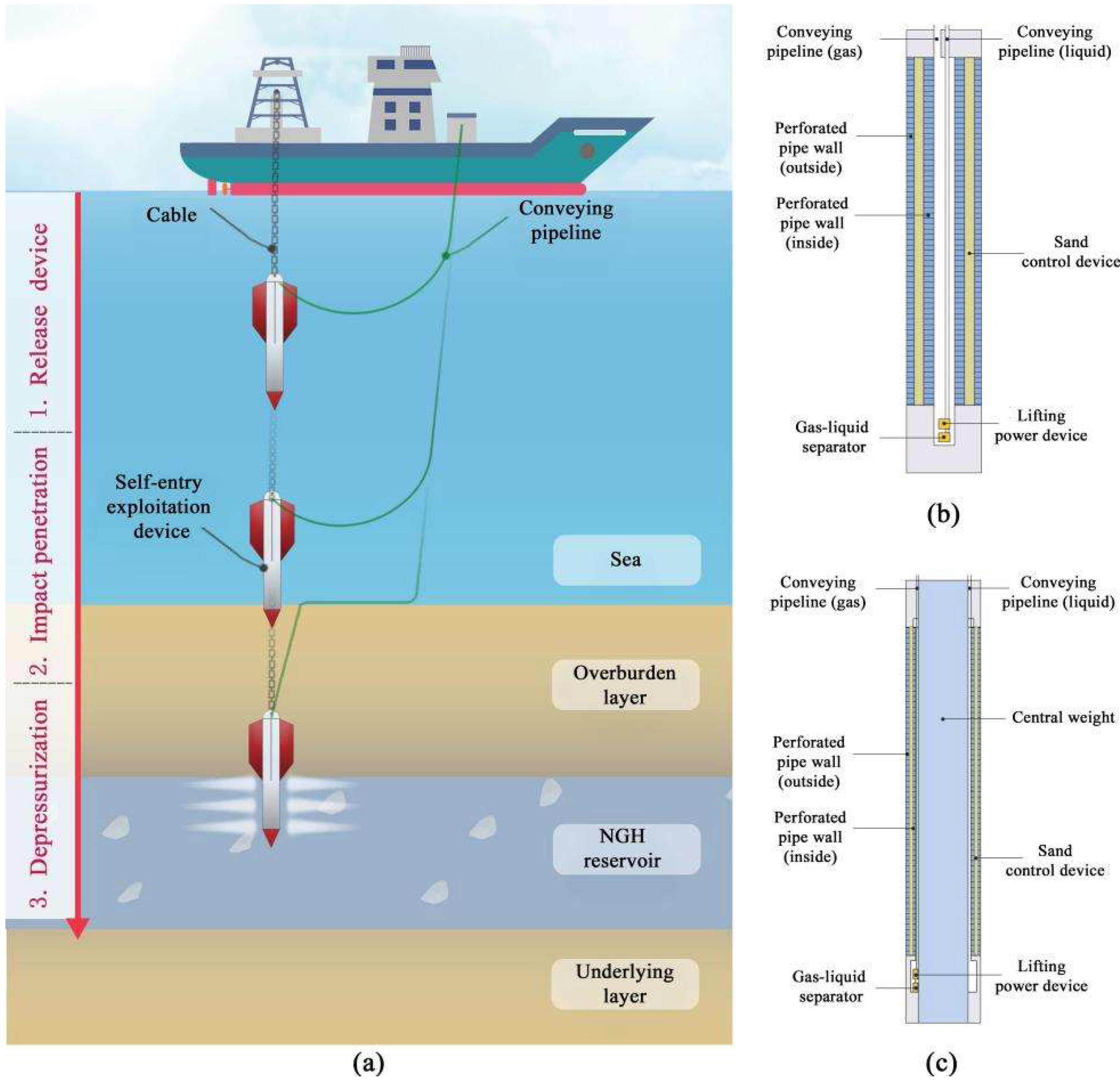


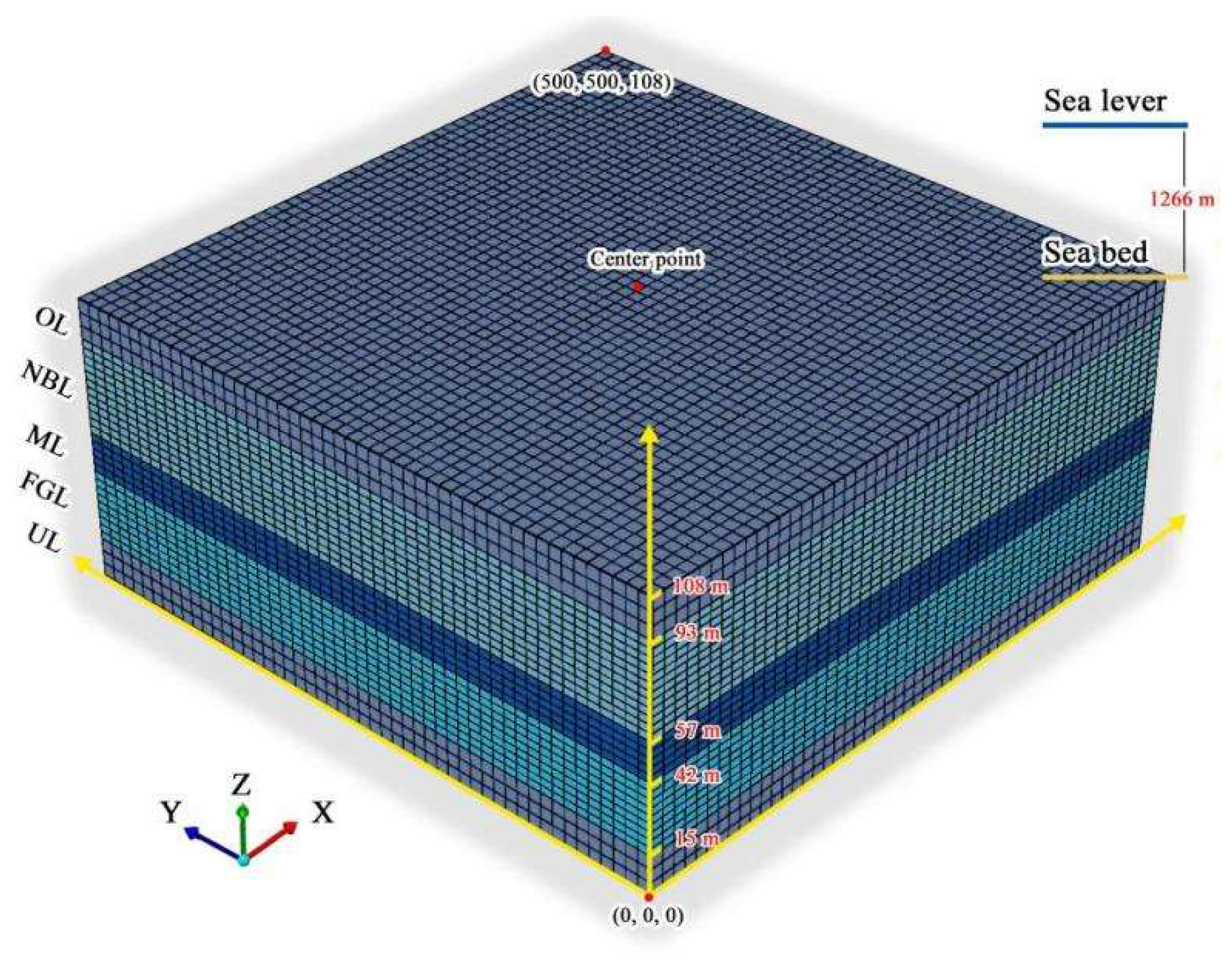
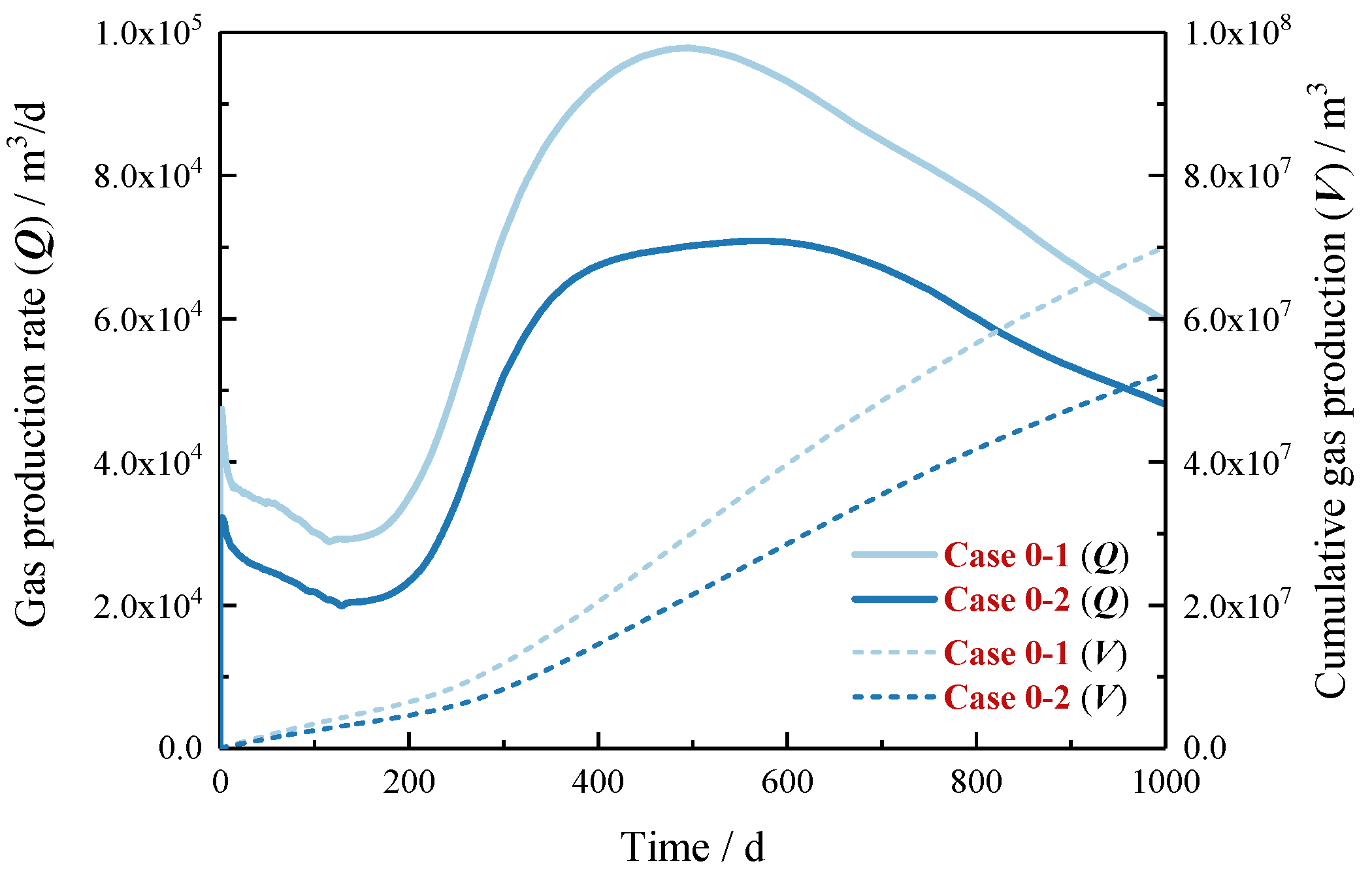
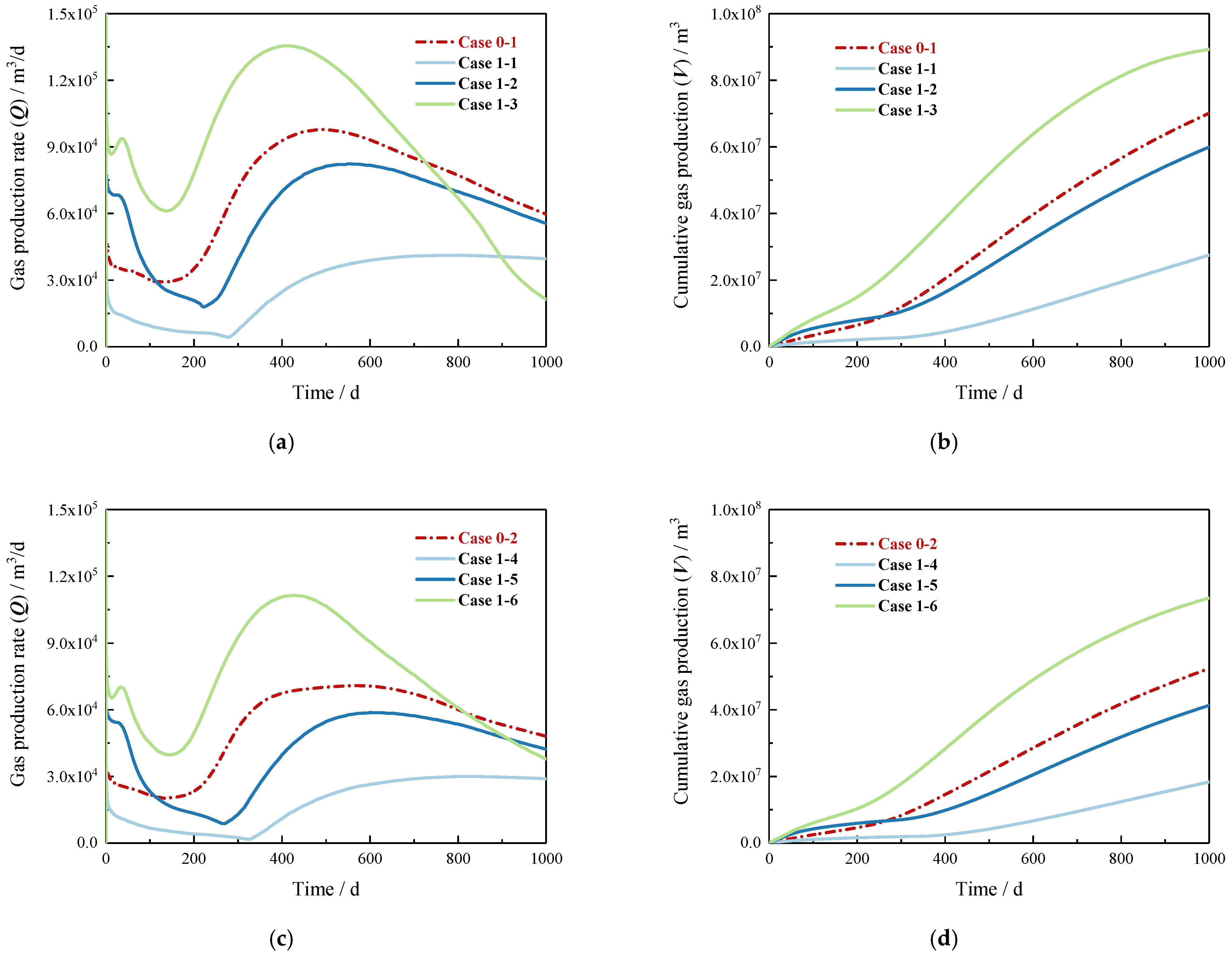
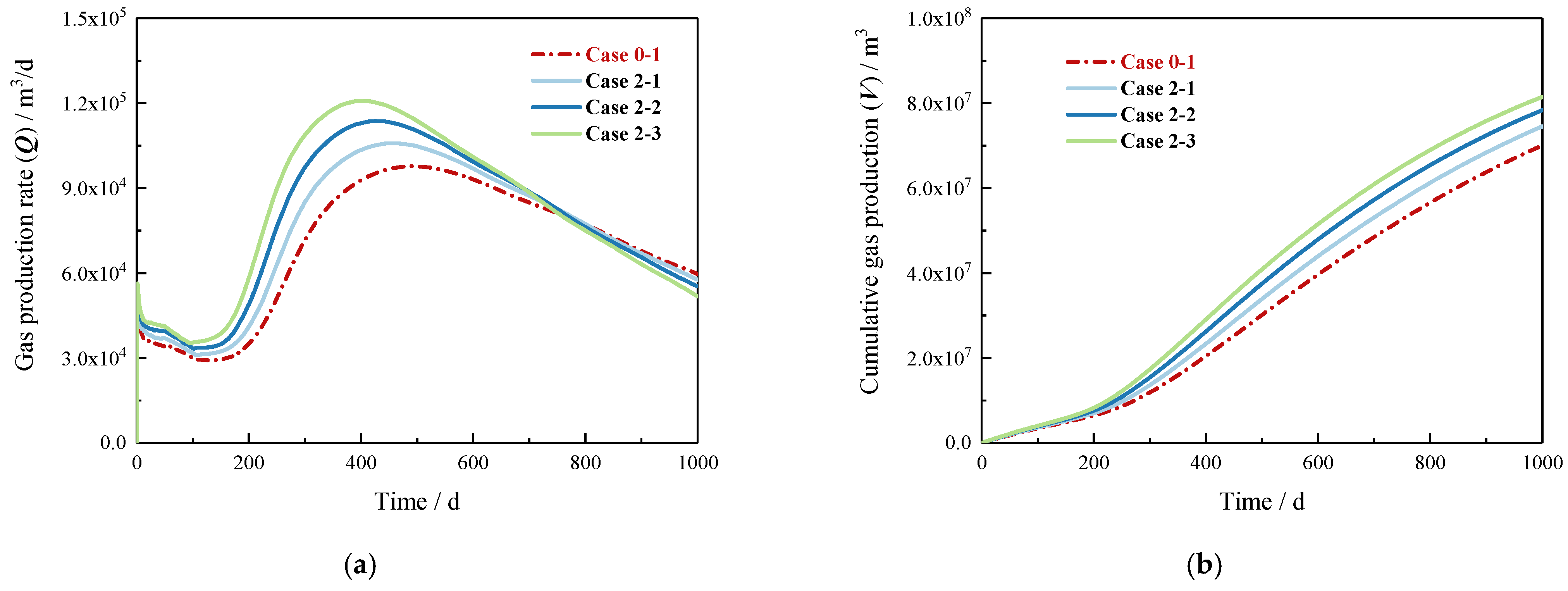
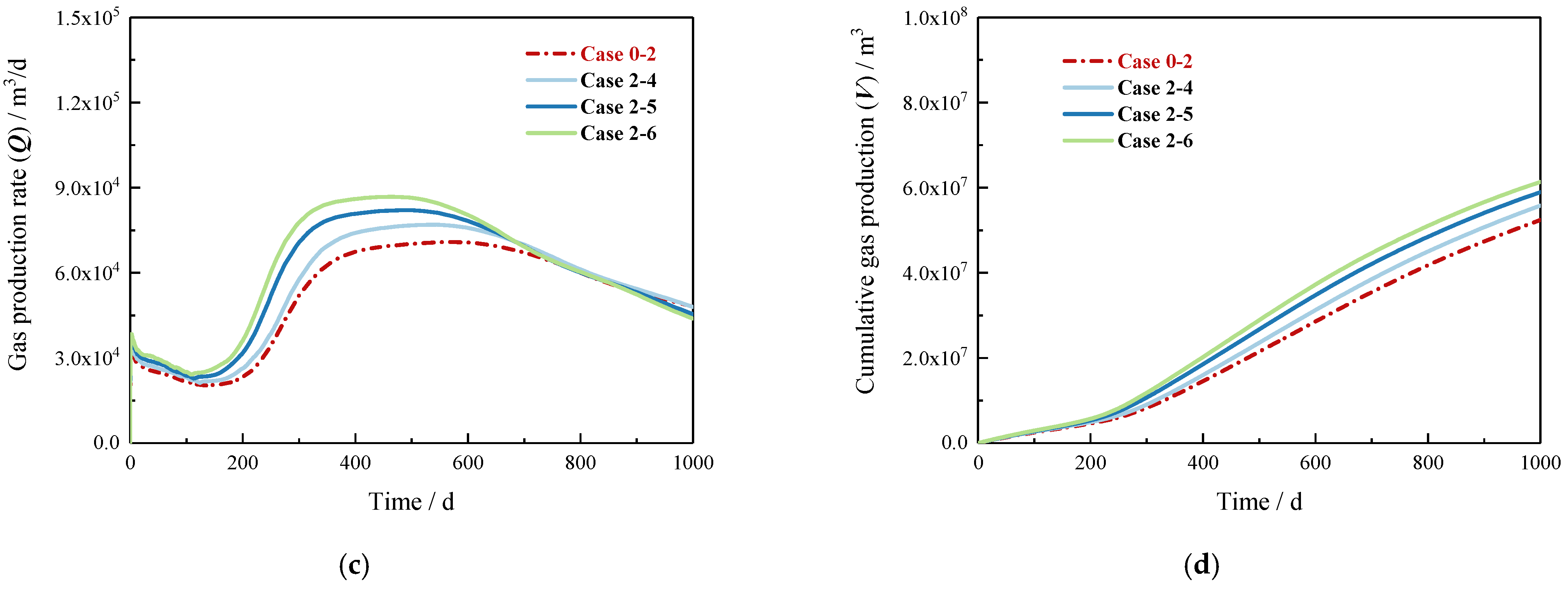
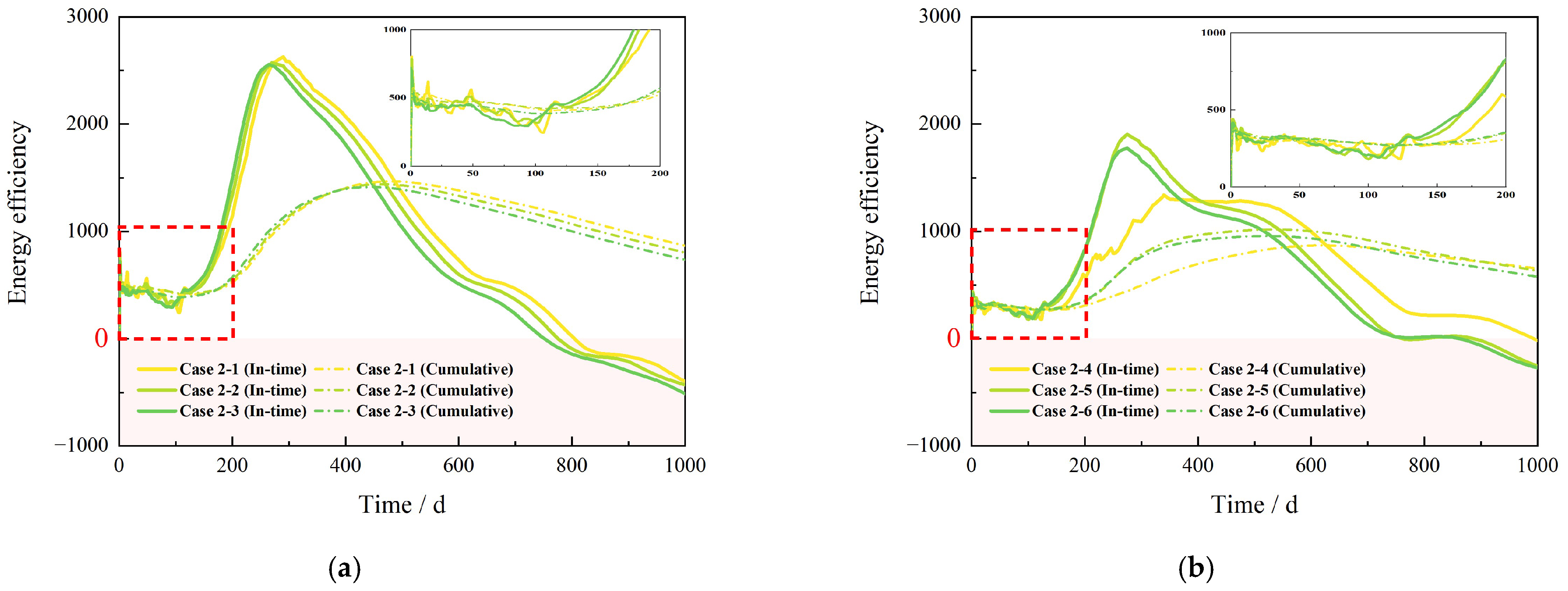
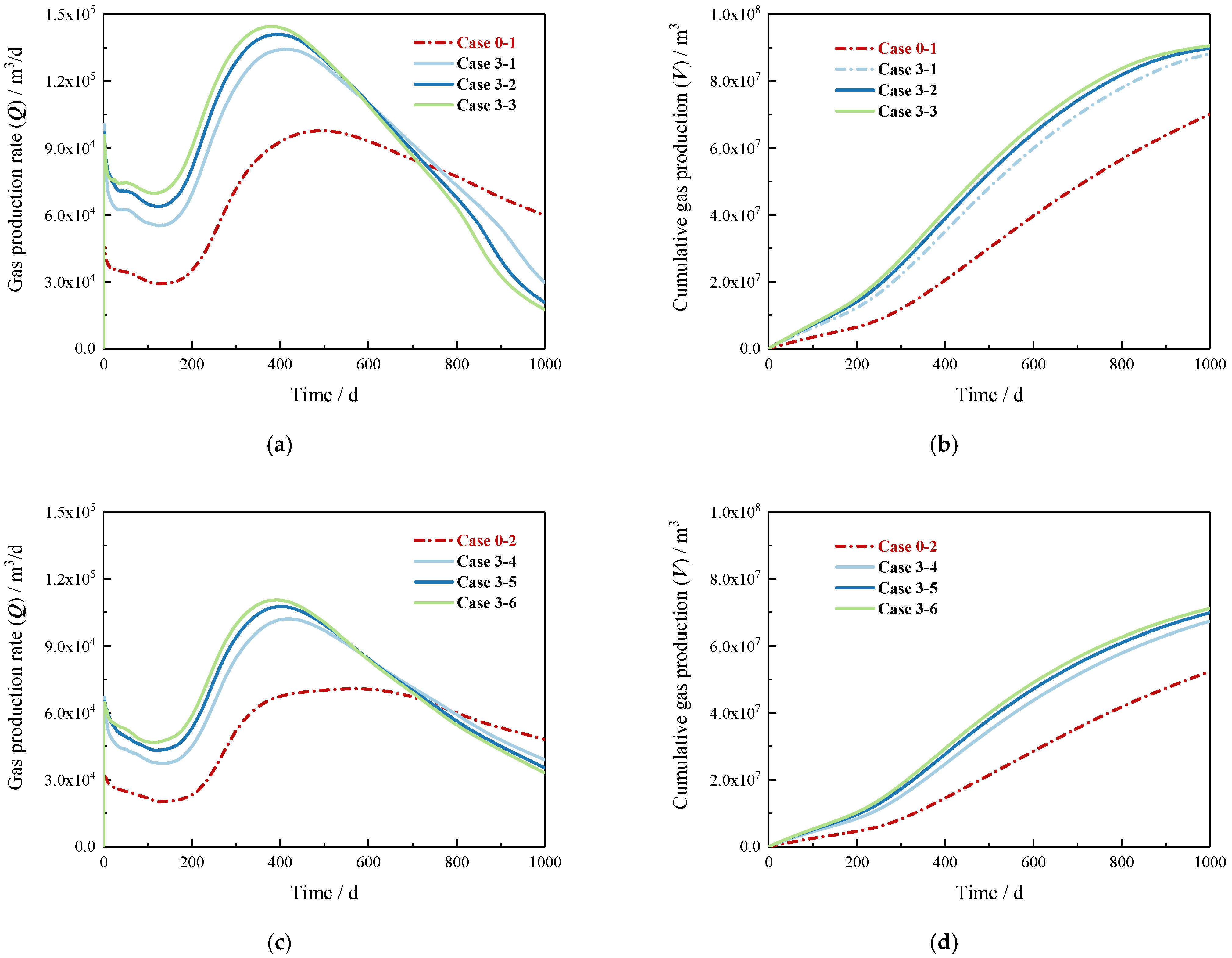

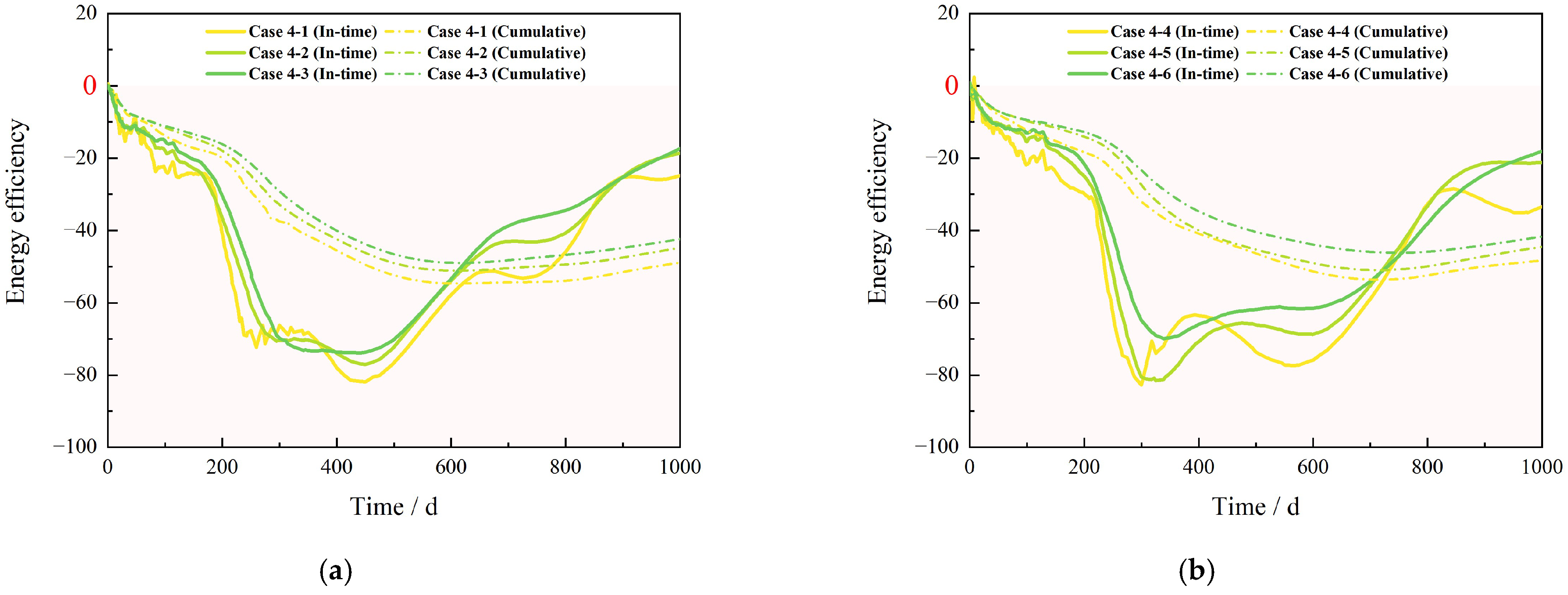
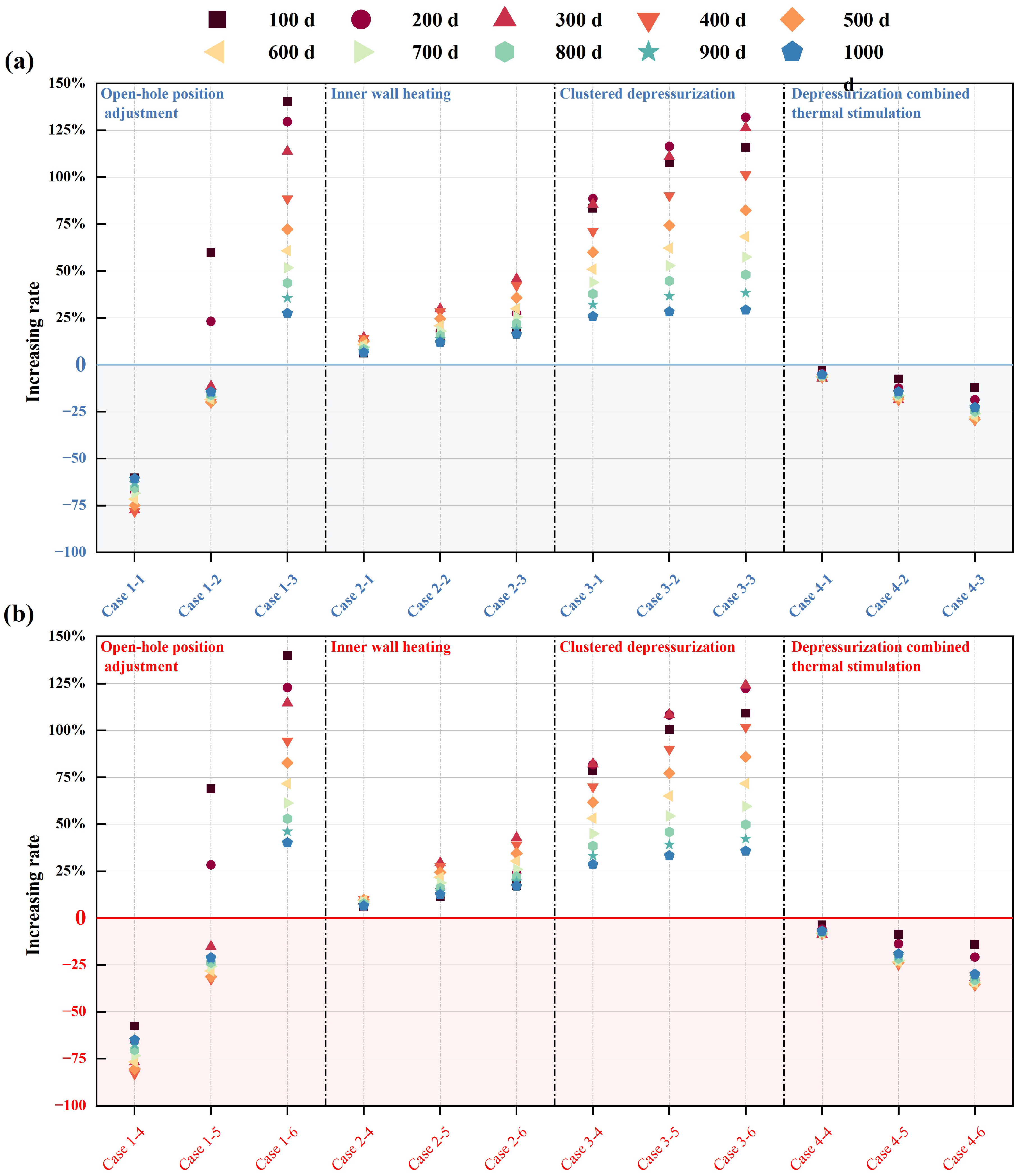
| No. | Production Pressure | Opening Position |
|---|---|---|
| Case 0–1 | 1 MPa | NBL |
| Case 0–2 | 4 MPa | NBL |
| No. | Production Pressure | Open-Hole Position |
|---|---|---|
| Case 1–1 | 1 MPa | ML |
| Case 1–2 | 1 MPa | FGL |
| Case 1–3 | 1 MPa | NBL + ML + FGL |
| Case 1–4 | 4 MPa | ML |
| Case 1–5 | 4 MPa | FGL |
| Case 1–6 | 4 MPa | NBL + ML + FGL |
| No. | Production Pressure | Heating Power |
|---|---|---|
| Case 2–1 | 1 MPa | 2 kW |
| Case 2–2 | 1 MPa | 4 kW |
| Case 2–3 | 1 MPa | 6 kW |
| Case 2–4 | 4 MPa | 2 kW |
| Case 2–5 | 4 MPa | 4 kW |
| Case 2–6 | 4 MPa | 6 kW |
| No. | Production Pressure | Spacing |
|---|---|---|
| Case 3–1 | 1 MPa | 20 m |
| Case 3–2 | 1 MPa | 60 m |
| Case 3–3 | 1 MPa | 100 m |
| Case 3–4 | 4 MPa | 20 m |
| Case 3–5 | 4 MPa | 60 m |
| Case 3–6 | 4 MPa | 100 m |
| No. | Production Pressure | Water Injection Rate |
|---|---|---|
| Case 4–1 | 1 MPa | 20 m3/d |
| Case 4–2 | 1 MPa | 60 m3/d |
| Case 4–3 | 1 MPa | 100 m3/d |
| Case 4–4 | 4 MPa | 20 m3/d |
| Case 4–5 | 4 MPa | 60 m3/d |
| Case 4–6 | 4 MPa | 100 m3/d |
Disclaimer/Publisher’s Note: The statements, opinions and data contained in all publications are solely those of the individual author(s) and contributor(s) and not of MDPI and/or the editor(s). MDPI and/or the editor(s) disclaim responsibility for any injury to people or property resulting from any ideas, methods, instructions or products referred to in the content. |
© 2023 by the authors. Licensee MDPI, Basel, Switzerland. This article is an open access article distributed under the terms and conditions of the Creative Commons Attribution (CC BY) license (https://creativecommons.org/licenses/by/4.0/).
Share and Cite
Wang, J.; Ye, H.; Chen, J.; Huang, Q.; Guo, G.; Huang, X.; Zi, M.; Li, D.; Wu, X. Marine Natural Gas Hydrate Self-Entry Exploitation Device: Evaluation of Production Enhancement Measures. J. Mar. Sci. Eng. 2023, 11, 543. https://doi.org/10.3390/jmse11030543
Wang J, Ye H, Chen J, Huang Q, Guo G, Huang X, Zi M, Li D, Wu X. Marine Natural Gas Hydrate Self-Entry Exploitation Device: Evaluation of Production Enhancement Measures. Journal of Marine Science and Engineering. 2023; 11(3):543. https://doi.org/10.3390/jmse11030543
Chicago/Turabian StyleWang, Jianhua, Hongyu Ye, Jingyu Chen, Qichao Huang, Gaoqiang Guo, Xuhong Huang, Mucong Zi, Dayong Li, and Xuezhen Wu. 2023. "Marine Natural Gas Hydrate Self-Entry Exploitation Device: Evaluation of Production Enhancement Measures" Journal of Marine Science and Engineering 11, no. 3: 543. https://doi.org/10.3390/jmse11030543
APA StyleWang, J., Ye, H., Chen, J., Huang, Q., Guo, G., Huang, X., Zi, M., Li, D., & Wu, X. (2023). Marine Natural Gas Hydrate Self-Entry Exploitation Device: Evaluation of Production Enhancement Measures. Journal of Marine Science and Engineering, 11(3), 543. https://doi.org/10.3390/jmse11030543







